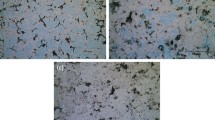Compact samples are produced from antimony-doped tin dioxide in a high-pressure cell at a hydrostatic pressure of 4 GPa and a temperature of 873 K. Pressure–temperature treatment has resulted in a material exhibiting high density and hardness. Its electrical and physical properties are studied. The temperature dependence of resistivity shows that the test material is a degenerate semiconductor with low (1.5 meV) activation energy.






Similar content being viewed by others
References
P. R. Bueno and J. A. Varela, “Electronic ceramics based on polycrystalline SnO2, TiO2 and (Sn x Ti1-x )O2 solid solution,” Mater. Res., 9, No. 3, 293–300 (2006).
J. Fan, H. Zhaoa, Y. Xi, et al., “Characterization of SnO2–CoO–MnO–Nb2O5 ceramics,” J. Europ. Ceram. Soc., 30, 545–548 (2010).
J. A. Aguilar-Martinez, A. B. Glot, A. V. Gaponov, et al., “Current–voltage characteristics of SnO2– Co3O4–Cr2O3–Sb2O5 ceramics,” J. Phys. D: Appl. Phys., 42, No. 20, 5401 (2009).
D. Maestre, A. Cremades, and J. Piqueras, “Direct observation of potential barrier formation at grain boundaries of SnO2 ceramics,” Semicond. Sci. Technol., 19, 1236–1239 (2004).
T. Krishnakumar, R. Jayaprakash, N. Pinna, et al., “Sb–SnO2-nanosized-based resistive sensors for NO2 detection,” J. Sensors, 2009, 965 (2009).
J. A. Varela, J. A. Cerri, E. R. Leite, et al., “Microstructural evolution during sintering of CoO doped SnO2 ceramics,” Ceram. Int., 25, 253–256 (1999).
M. Yoshinaka, K. Hirota, M. Ito, et al., “Hot isostatic pressing of reactive SnO2 powder,” J. Am. Ceram. Soc., 82, No. 1, 216–218 (1999).
O. Scarlat, S. Mihaiu, Gh. Aldica, et al., “Enhanced properties of tin oxide (IV) based materials by field activated sintering,” J. Am. Ceram. Soc., 86, No. 6, 893–897 (2003).
I. Saadeddin, H. S. Hilal, B. Pecquenard, et al., “Simultaneous doping of Zn and Sb in SnO2 ceramics: Enhancement of electrical conductivity,” Solid State Sci., 8, 7–13 (2006).
J. A. Aguilar-Martinez, M. B. Hernandez, A. B. Glot, et al., “Microstructure and electrical properties in SnO2 ceramics with sequential addition of Co, Sb and Ca,” J. Phys. D: Appl. Phys., 40, No. 22, 7097–7102 (2007).
O. D. Jayakumar, V. Sudarsan, and S. K. Kulshreshtha, “Metallic nature of Sn1–x Sb x O2±δ (x = 0.0, 0.10, and 0.20) mixed oxides: probed by 119Sn MAS NMR,” Phys. B: Condens. Matter, 392, No. 1–2, 67–71 (2007).
G. Qin, D. Li, Z. Chen, et al., “Structural, electronic and optical properties of Sn1–x Sb x O2,” Comput. Mat. Sci., 46, No. 2, 418–424 (2009).
R. G. Duan, G. D. Zhan, J. D. Kuntz, et al., “Processing and microstructure of high-pressure consolidated ceramic nanocomposites,” Scripta Mater., 51, No. 12, 1135–1139 (2004).
L. D. Loch, “The semiconducting nature of stannic oxide,” J. Electrochem. Soc., 110, No. 10, 1081–1083 (1963).
M. Batzill and U. Diebold, “The surface and materials science of tin oxide,” Prog. Surf. Sci., 79, No. 2–4, 47–154 (2005).
D. E. Dyshel’, “Influence of the phase composition on the electrical conductivity of gas sensors based on antimony-doped tin dioxide films,” Powder Metall. Met. Ceram., 40, No. 5–6, 282–291 (2001).
C. A. Vincent, “Preparation and properties of semiconducting polycrystalline tin oxide,” J. Electrochem. Soc., 119, No. 4, 518–521 (1972).
Acknowlegements
The study has been supported by the Science & Technology Center of Ukraine, Project No. 3927.
Author information
Authors and Affiliations
Corresponding author
Additional information
Translated from Poroshkovaya Metallurgiya, Vol. 51, No. 3–4 (484), pp. 82–89, 2012.
Rights and permissions
About this article
Cite this article
Gonchar, A.G., Rud’, B.M., Bykov, A.I. et al. Effect of pressure–temperature treatment on the properties of antimony-doped tin dioxide. Powder Metall Met Ceram 51, 191–197 (2012). https://doi.org/10.1007/s11106-012-9416-3
Received:
Published:
Issue Date:
DOI: https://doi.org/10.1007/s11106-012-9416-3




